Laurie Accede
AP Art History 🖼
34 resourcesSee Units
Conical Tower and Circular Wall of Great Zimbabwe
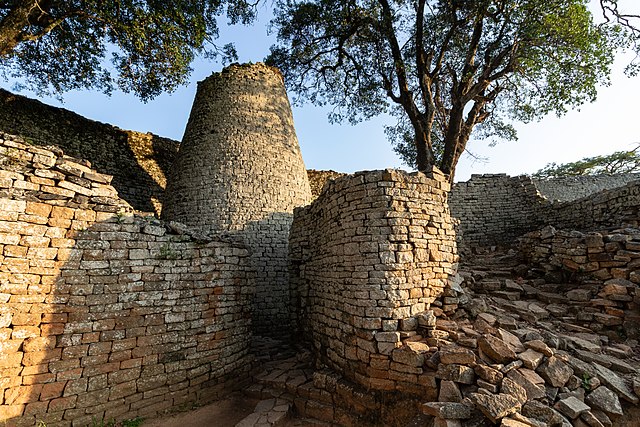
Image Courtesy of Wikipedia
- Coursed granite blocks
Function:
- This was a royal complex (the royal elite may have lived here) and trading center
Content:
- This was a 32 feet tall fortress with sloped sides
Context:
- The large size of the conical tower is a symbol of wealth and power. It also resembled a granary (a building that was used to store grain) to represent prosperity and a successful harvest
- The name Zimbabwe means "houses of stones," and this structure is different from many other architectural buildings in Africa because it's made from stone.
Great Mosque of Djenné
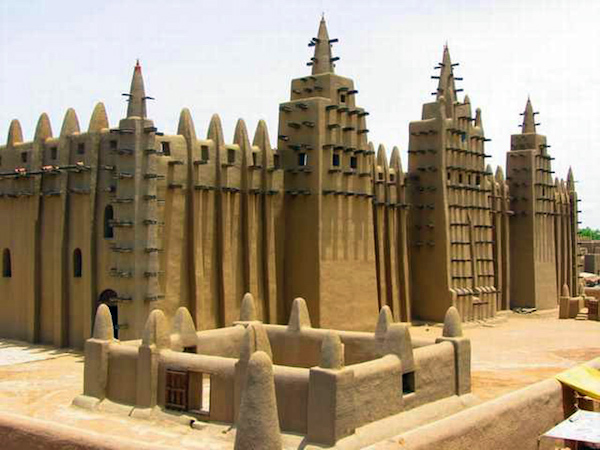
Image Courtesy of Khan Academy
Form:
- Adobe
Function:
- This was a mosque where Muslims could come to pray and worship
Content:
- Maintains the tradition of Islamic mosques, with a mihrab that indicates the direction of Mecca
- Wooden beams called torons are found on the mosque walls and are used as ladders for when maintenance is done on the building
- Minarets (used to call Muslim worshippers to pray) and other columns are topped with ostrich eggs as a symbol of purity and fertility
- The mosque also has a hypostyle hall, which is an interior space with a roof supported by columns. This hypostyle hall provided space for the umma (Muslim community) to pray
Context:
- One of the five pillars of Islam requires Muslims to pray 5 times a day facing Mecca
- This structure is made from natural materials, the mosque requires maintenance it order to combat the weather and other events. The Town of Djenné holds an annual festival known as Crépissage de La Grand Mosque, where citizens come together to repair and re-plaster the Great Mosque.
Wall Plaque, from Oba’s Palace
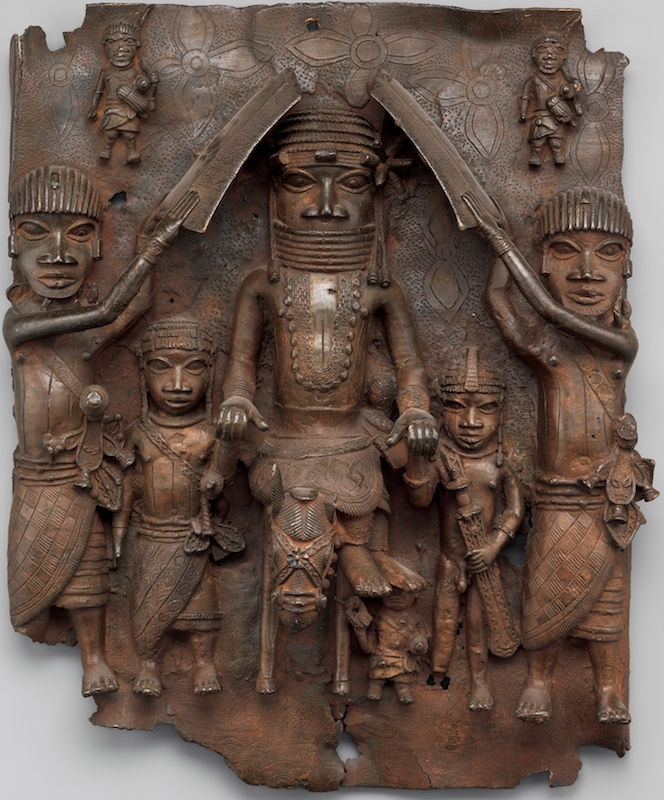
Image Courtesy of Khan Academy
- Cast brass
Function:
- The plaque was made to decorate the palace of the oba (the king) and showcase his power and wealth
Content:
- Hierarchy of scale is used, where the most important figure, the king is the largest
- The king is shown with his attendants
Context:
- This place comes from the Edo peoples in Benin (present-day Nigeria)
- The use of brass demonstrates the trading networks that were formed, especially with the Portuguese
Sika Dwa Kofi (Golden Stool)
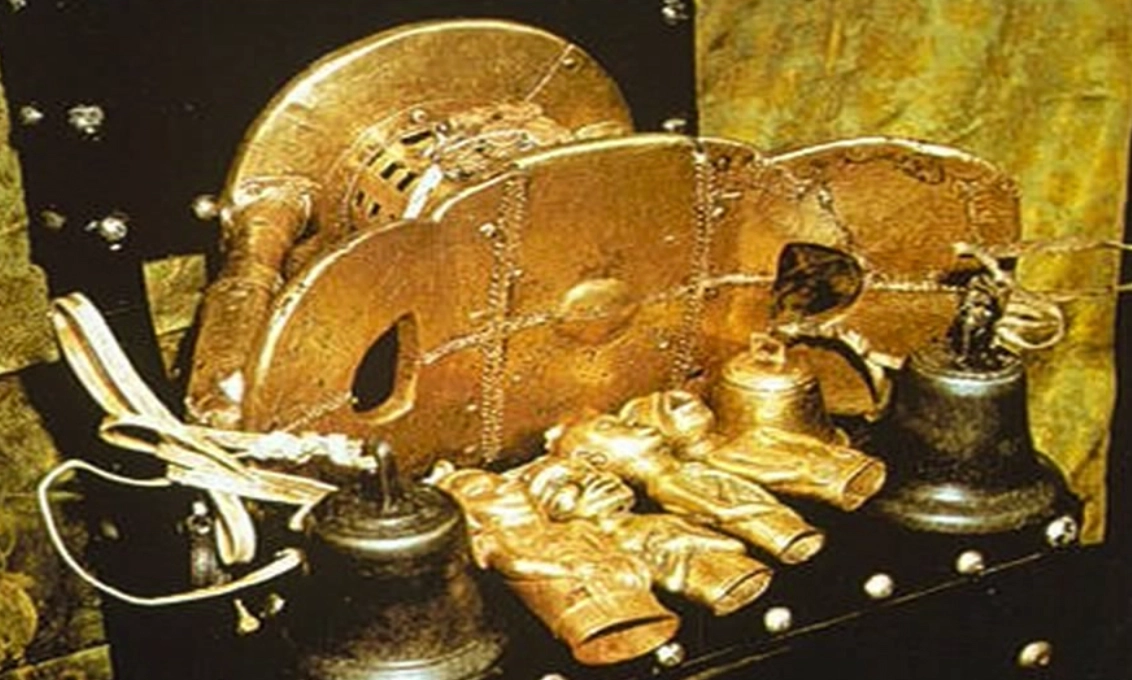
Image Courtesy of Smart History
- Gold over wood
Function:
- This was a sacred symbol of the Ashanti people in Ghana. It is said to contain the soul of the nation.
- This object was used during special occasions, like "crowning ceremonies," where the king is raised over the stool
Content:
- There are bells hanging from the side of the stool to warn the king of danger
Context:
- Stools are culturally significant to the Ashanti nation (parts of own's souls are believed to reside in stool), and this stool was so sacred, it was never supposed to touch the ground. It rests on its own throne.
- No one is allowed to touch the stool except for the king
Ndop (Portrait Figure) of King Mishe miShyaang maMbul
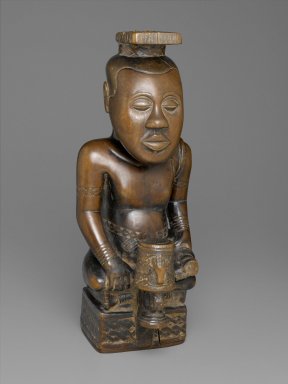
Image Courtesy of Khan Academy
- Wood
Function:
- These figures were meant to commemorate the king and their accomplishments
Content:
- This is a non-idealized sculpture of the king who is wearing royal regalia and is sitting with his legs crossed on a stool
- The large head demonstrates the king's intelligence
- The calm-looking face shows the king's patience and he seems uninvolved. He is above "mortal" affairs
Context:
- This figure was kept in a shrine
- The shine in this wooden sculpture comes from the oils that were rubbed on it to protect it from insects
- The motifs on the drum identifies this figure as King Mishe miShyaang maMbul
Power Figure (Nkisi n’kondi )
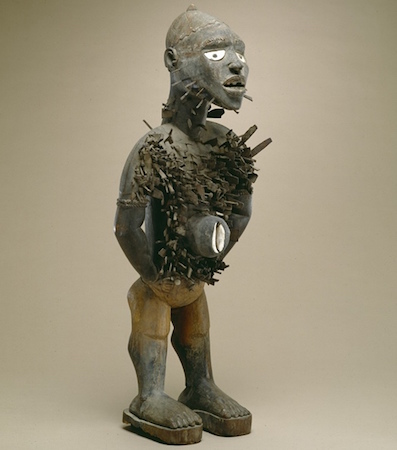
Image Courtesy of Khan Academy
- Wood and metal
Function:
- This was used to hold spirits
Content:
- This is a human figure who is standing and is an alert pose
- Nails are pounded throughout the sculpture
Context:
- The Nkisi (''spirit") contained in the figure can be called upon to assist in human affairs
- The nails were inserted to call upon the spirit, especially for serious affairs
Female (Pwo) Mask
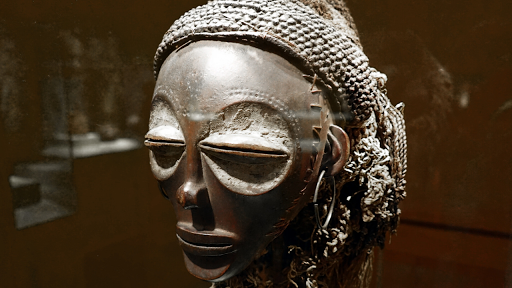
Image Courtesy of Khan Academy
- Wood, fiber, pigment, and metal
Function:
- These masks were worn by men who depicted women in ritual dances
Content:
- Closed eyes with enlarged sockets and a slender nose
- Braided fibers are used for hair
Context:
- The Chokwe peoples were a matrilineal society and these masks were used to honor female ancestors
- The facial features represent an ideal woman in Chokwe society
- The eyes suggest wisdom and modesty (she is so knowledgeable that she does not need sight)
- The large forehead is also a symbol of intelligence
- The white around the eyes is meant to demonstrate a connection to the spirtual world
Portrait Mask (Mblo)
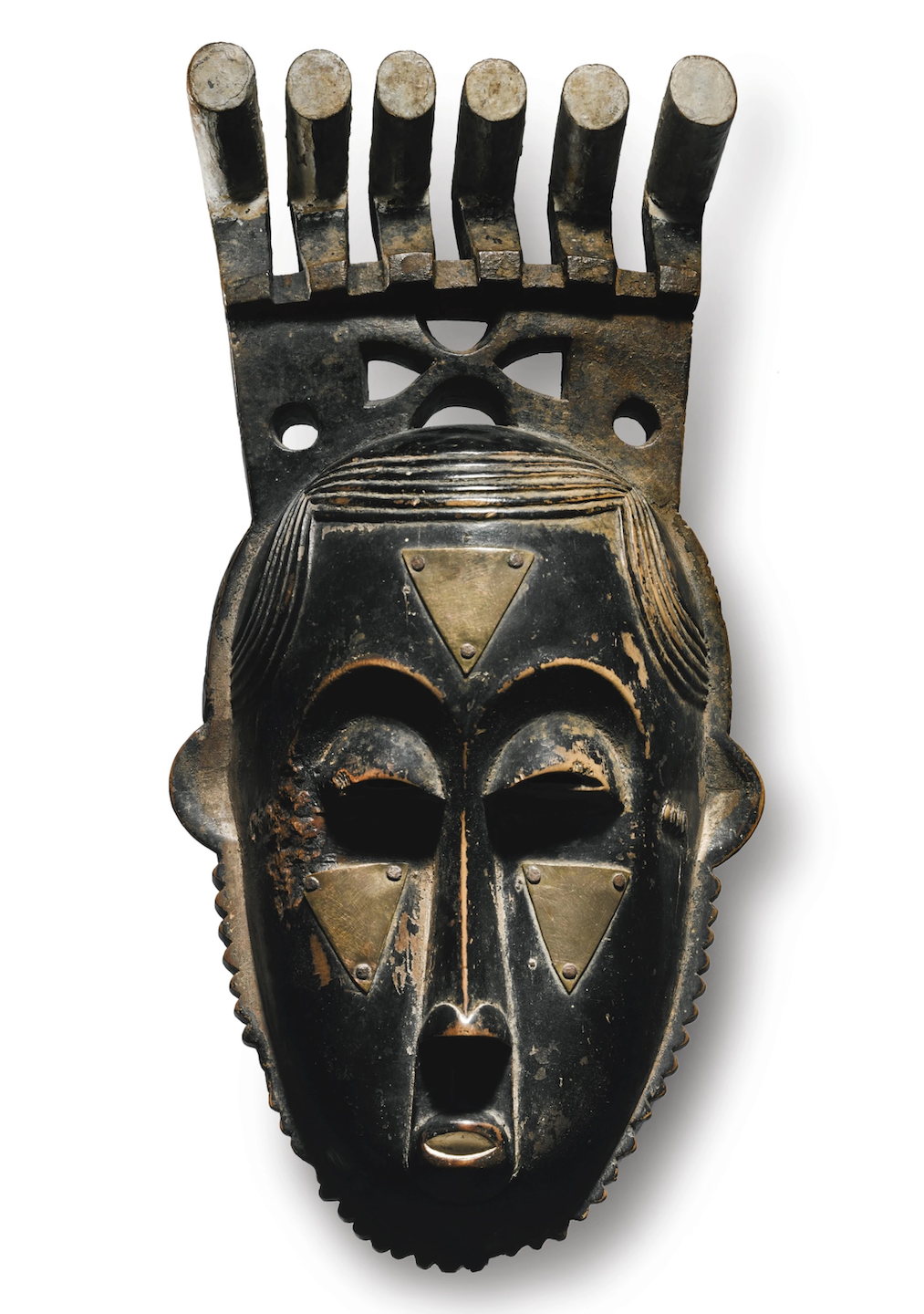
Image Courtesy of Khan Academy
- Wood and pigment
Function:
- These masks were worn at ritual dances to honor an individual
Content:
- Facial features include: arched eyebrows, broad forehead, heavy-lidded and downcast eyes, slender and elongated nose, small mouth, elaborate coiffure (hairstyle), elongated facial structure
Context:
- These masks are from the Baule peoples of Côte d'Ivoire (Ivory Coast)
- This is an idealized version of the individual, and the facial features represent desired attributes in Baule society, including modesty, wisdom, and morality
Bundu Mask
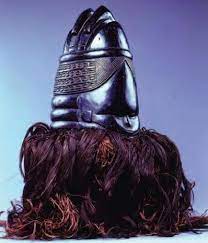
Image Courtesy of Marsha K. Russell
Form;
- Wood, cloth, and fiber
Function:
- These masks were worn by the elders of Sande society during initiation ceremonies that brought young girls into Sande society and celebrated their adulthood
Content:
- Facial features include: small eyes, small ears, small mouth, smooth and broad forehead, elaborate hairstyle, rings around the neck
Context:
- The masks portray the ideal Mende woman.
- Small eyes and ears represent a woman who avoids sharing secrets and gossip
- The elaborate hair is a symbol of wealth
- The large and high forehead demonstrates wisdom
- The rings around the neck are symbolic of pregnancy
Ikenga (Shrine Figure)

Image Courtesy of Wikipedia
- Wood
Function:
- These figures were commissioned by men for their private homes as a symbol of of their achievements
Content:
- Ikenga means "strong right arm" and the tool in the figures hand demonstrates the person's strong physical capabilities
- The horns of a ram demonstrate power and strength
Context:
- This figure honors masculine attributes
Lukasa (Memory Board)
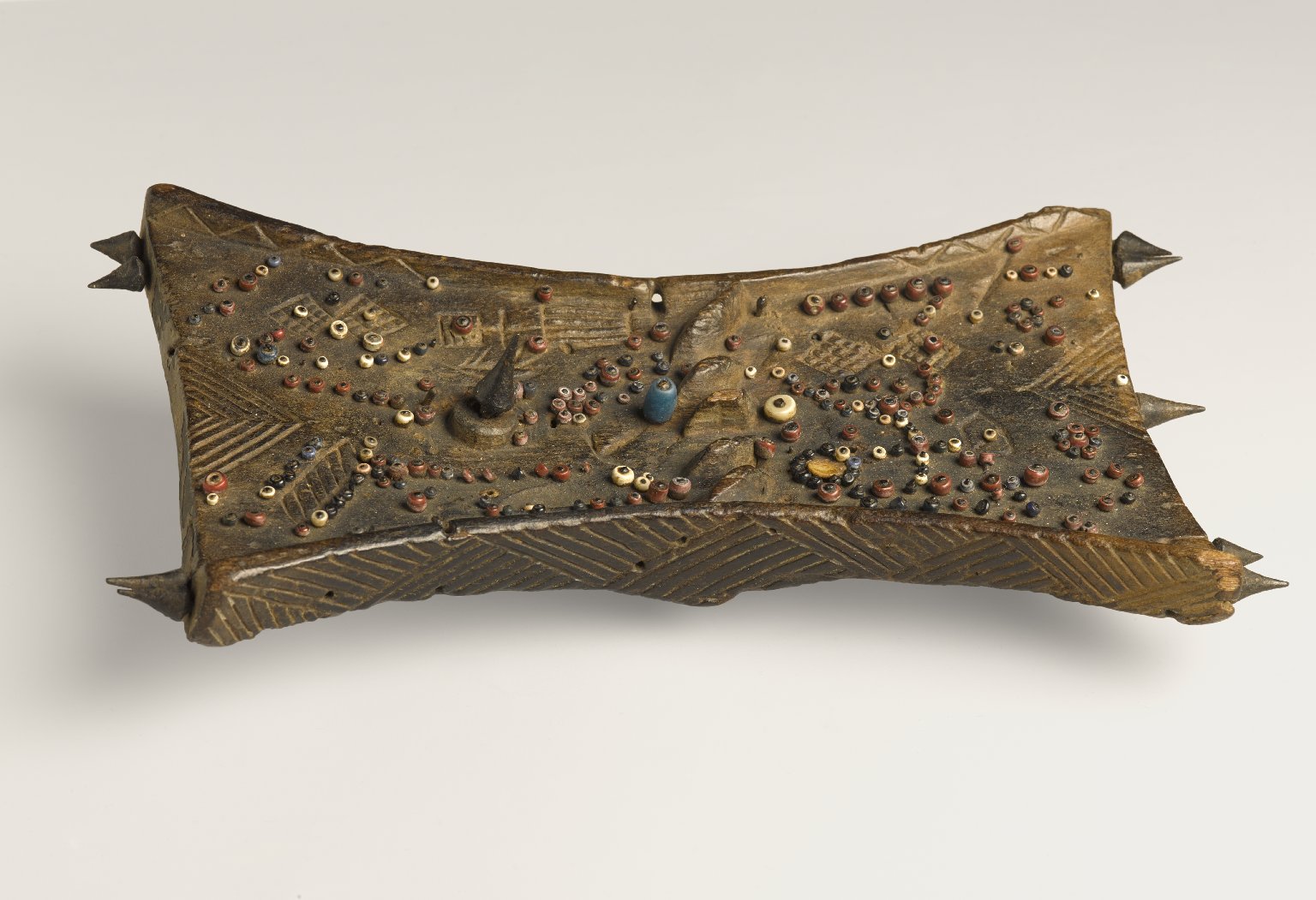
Image Courtesy of Brooklyn Museum
Form:
- Wood, beads, and metal
Function:
- This was used to help the user remember key elements of a story
- Carved wood decorated with beads and shells with each bead representing a particular element in the story
- Zoomorphic elements are carved into the sides of the board
Context:
- These were used by the historians in Mbudye society, who have the special ability to read these boards
- Each board was unique depending on the story
Aka Elephant Mask
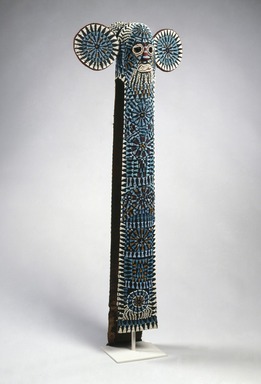
Image Courtesy of Brooklyn Museum
- Wood, woven raffia, cloth, and beads
Function:
- These masks were worn by members of high society (members of the Kuosi) during important ceremonies
Content:
- The figure is a composite human-animal figure (anthropomorphic)
- It has a human face with elephant features (long trunk and ears) that symbolize power and strength
Context:
- Beads were valuable items of the Bamileke people. The beadwork and elephant features were signs of wealth and prestige
Reliquary Figure (Byeri)
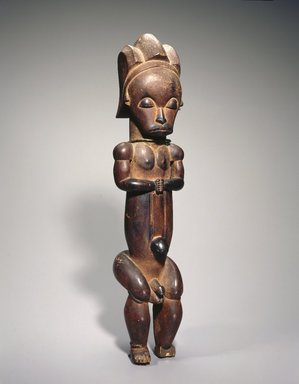
Image Courtesy of Brooklyn Museum
- Wood
Function:
- These figures were placed on reliquaries (containers that store relics) to act as guards from bad spirits
Content:
- Hands folded in prayer to symbolize tranquility
- Prominent belly button to symbolize eternal life and youthfulness
- Elongated body
Context:
- Similar to the Ndop portrait figure, this sculpture was also rubber with oil to add shine and protect from insects
- This figure was meant to be portable since the Fang people were nomadic
Veranda Post of Enthroned King and Senior Wife (Opo Ogoga)
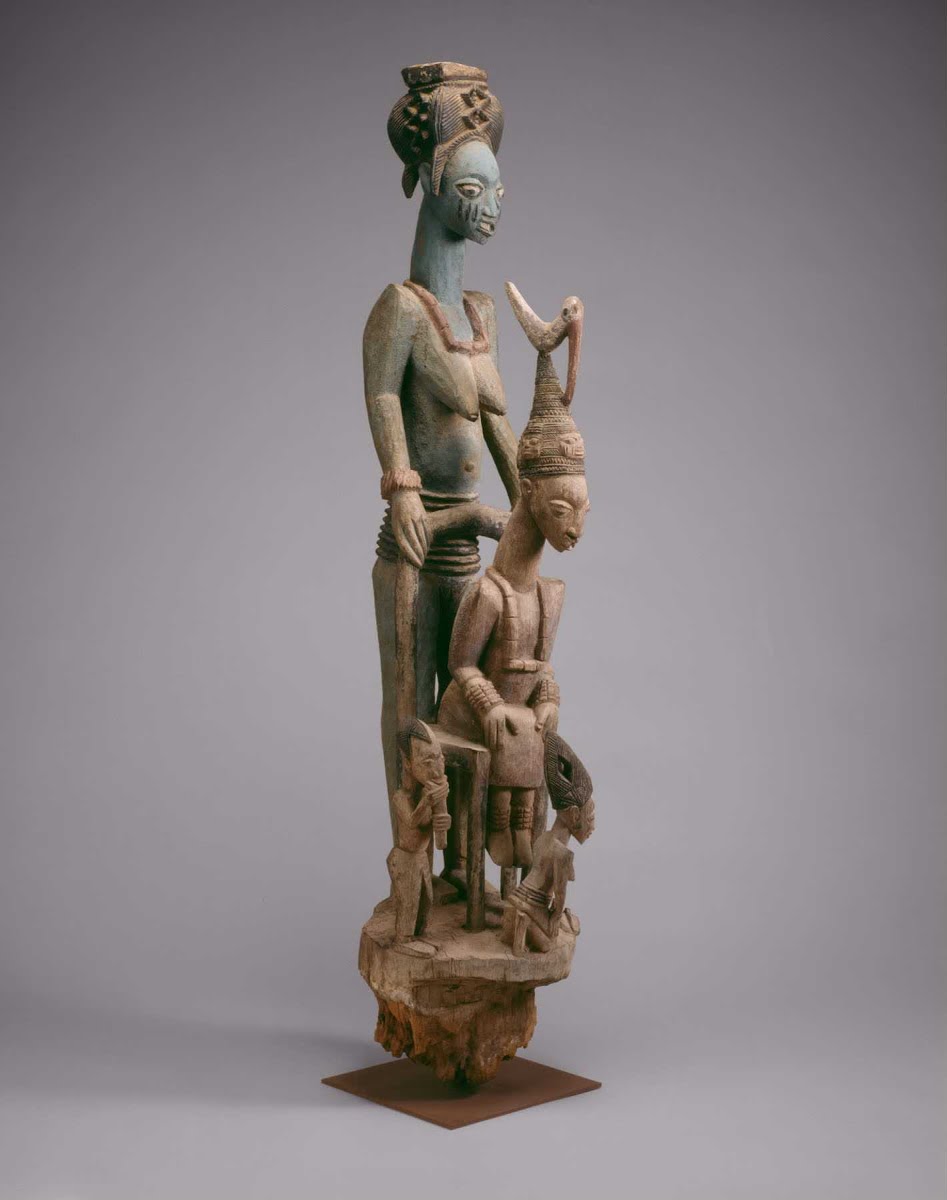
Image Courtesy of Google Arts and Culture
Form:
- Wood and pigment
Function:
- This was most likely used for decoration of the king's palace. These posts also helped support a veranda (porch-like structure) in the palace
Content:
- The use of hierarchy of scale were she is larger than the king, shows that she is an important supporter of the king (cross cultural comparison with King Menkaura and Queen in Unit 2 🧠)
- There is a smaller figure, the King's Junior Wife and a Eshu, the Trickster god of the Yoruba peoples playing the flute
Context:
- The carver of this piece was Olowe of Ise
Browse Study Guides By Unit
🗿Unit 1 – Global Prehistoric Art, 30,000-500 BCE
🏛Unit 2 – Ancient Mediterranean Art, 3500-300 BCE
⛪️Unit 3 – Early European and Colonial American Art, 200-1750 CE
⚔️Unit 4 – Later European and American Art, 1750-1980 CE
🌽Unit 5 – Indigenous American Art, 1000 BCE-1980 CE
⚱️Unit 6 – African Art, 1100-1980 CE
6.4Unit 6 Required Works
- Conical Tower and Circular Wall of Great Zimbabwe
- Great Mosque of Djenné
- Wall Plaque, from Oba’s Palace
- Sika Dwa Kofi (Golden Stool)
- Ndop (Portrait Figure) of King Mishe miShyaang maMbul
- Power Figure (Nkisi n’kondi )
- Female (Pwo) Mask
- Portrait Mask (Mblo)
- Bundu Mask
- Ikenga (Shrine Figure)
- Lukasa (Memory Board)
- Aka Elephant Mask
- Reliquary Figure (Byeri)
- Veranda Post of Enthroned King and Senior Wife (Opo Ogoga)
🕌Unit 7 – West and Central Asian Art, 500 BCE-1980 CE
🛕Unit 8 – South, East, and Southeast Asian Art, 300 BCE-1980 CE
🐚Unit 9: The Pacific, 700–1980 ce
🏢Unit 10 – Global Contemporary Art, 1980 CE to Present
📚Study Tools

Fiveable
Resources
© 2025 Fiveable Inc. All rights reserved.